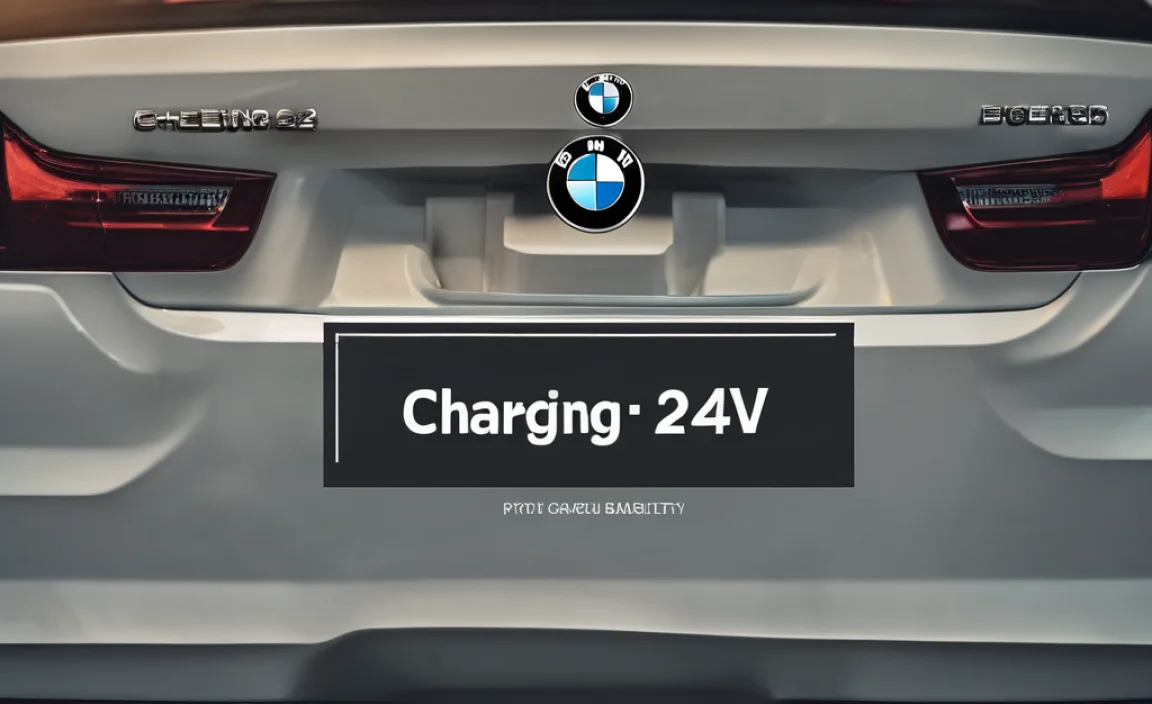Proper voltage for a car battery is typically 12.6 volts when fully charged and at rest. This guide explains how to check it safely and what it means for your car’s health, ensuring you can maintain your vehicle with confidence.
Ever wondered why your car sometimes struggles to start, or if your battery is still in good shape? It’s a common worry for many drivers, and often, the answer lies with your car battery’s voltage. Don’t let confusing numbers and technical terms stress you out! This guide is here to break down exactly what the proper voltage for a car battery should be, why it matters, and how you can easily check it yourself. We’ll walk through it step-by-step, making sure you feel confident and capable of keeping your car powered up and ready to go. Let’s demystify car battery voltage together!
Understanding Car Battery Voltage: The Basics
Your car battery isn’t just about starting your engine; it’s the powerhouse for all your car’s electrical systems. From the radio and lights to the computer controlling your engine, everything relies on a stable electrical current provided by the battery. The “voltage” is essentially a measure of the electrical pressure within the battery. Think of it like water pressure in a hose – too low, and things won’t work efficiently; too high, and you might cause damage.
A car battery works by a chemical reaction that creates electricity. This reaction typically involves lead plates submerged in an electrolyte solution. When you turn the key or push the start button, this chemical reaction speeds up, sending a powerful surge of electricity to start your engine. When the engine is running, the alternator takes over, supplying power to the car’s systems and also recharging the battery. It’s a dynamic system, and voltage is the key indicator of how well it’s all working.
What is the “Proper” Voltage?
When we talk about the “proper voltage for a car battery,” we’re usually referring to its state of charge when the engine is off and the car has been sitting for a while (at least a few hours, or preferably overnight). This is known as the resting voltage.
- Fully Charged Battery: A healthy, fully charged car battery should read around 12.6 volts or slightly higher when the engine is off.
- Partially Discharged Battery: If you check the voltage and it’s lower than 12.4 volts, the battery is starting to lose its charge.
- Severely Discharged Battery: A reading below 12.2 volts indicates a significantly discharged battery, which might struggle to start your car or could be on its way out.
- Bad Battery: If you’re seeing readings below 12.0 volts even after a good rest, the battery might be failing or have a short circuit.
It’s important to note that these are general guidelines. Factors like battery age, temperature, and the specific type of battery can cause slight variations. However, a reading consistently below 12.4 volts when at rest is a strong signal that something needs attention.
Why Voltage Matters: More Than Just Starting
The voltage of your car battery directly impacts its ability to perform its job effectively. Beyond just starting the engine, proper voltage ensures that all your car’s electronic components receive the clean, stable power they need to function correctly.
- Starting Power: A battery with insufficient voltage won’t have enough “kick” to turn over the engine, especially in cold weather.
- Electronics: Modern cars are packed with sensitive electronics – the infotainment system, airbags, anti-lock brakes, and the Engine Control Unit (ECU). These systems require a stable voltage to operate without errors or potential damage. Voltage drops can cause glitches, check engine lights, or even system failures.
- Alternator Health: The voltage reading can also give clues about your alternator’s health. If the voltage is too low even when the engine is running (more on that later), your alternator might not be charging the battery properly.
- Battery Lifespan: Consistently running on low voltage or frequently deep-discharging a battery can significantly shorten its lifespan. Keeping it at the proper voltage helps maintain its health and longevity.
Think of voltage as the “health score” for your battery and power system. A good score means everything runs smoothly; a low score is a warning sign that needs attention.
How to Check Your Car Battery Voltage: A Step-by-Step Guide
Checking your car battery voltage is a straightforward process that requires a simple tool: a multimeter. You can find affordable multimeters at most auto parts stores or online. Don’t worry if you’ve never used one before; it’s quite user-friendly.
What You’ll Need:
- A digital multimeter
- Safety glasses
- Gloves (optional, but recommended)
- A clean rag
Step-by-Step Instructions:
- Park Safely: Park your car on a level surface and ensure the parking brake is engaged. Turn off the engine and remove the keys from the ignition. It’s best to let the car sit for at least a few hours to get an accurate resting voltage.
- Locate the Battery: Open the hood and find your car battery. It’s usually a rectangular black box with two large terminals on top. Some cars have the battery in the trunk or under a seat; consult your owner’s manual if you’re unsure.
- Prepare the Terminals: Use the clean rag to wipe away any dirt, corrosion, or debris from the battery terminals (the metal posts where cables connect). Clean terminals ensure a good connection for your multimeter.
- Set Your Multimeter: Turn on your multimeter and set the dial to “DC Voltage” (often represented by V with a straight line and a dashed line above it, or VDC). Select a range that can measure at least 20 volts, as most car batteries operate around 12-14 volts.
- Connect the Red Probe: Touch the tip of the red probe (the positive probe) from the multimeter to the positive (+) terminal of the battery. This terminal is usually marked with a plus sign and might have a red cable connected to it.
- Connect the Black Probe: Touch the tip of the black probe (the negative probe) from the multimeter to the negative (-) terminal of the battery. This terminal is usually marked with a minus sign and might have a black cable connected to it.
- Read the Voltage: Look at the multimeter’s screen. It will display the current voltage of your battery.
- Interpret the Reading:
- 12.6V or Higher: Excellent! Your battery is fully charged.
- 12.4V – 12.6V: Good. Your battery is sufficiently charged.
- 12.2V – 12.4V: Fair. Your battery is partially discharged. You might want to consider charging it or having it checked.
- Below 12.2V: Poor. Your battery is significantly discharged and may not start your car. It needs immediate charging or professional inspection.
- Disconnect Probes: Carefully remove the black probe first, then the red probe from the battery terminals.
- Put Everything Away: Close the hood and store your multimeter safely.
Safety Note: Car batteries contain sulfuric acid and can produce flammable hydrogen gas. Always wear safety glasses when working near a battery, avoid creating sparks, and ensure good ventilation. For more detailed safety information, you can refer to resources from the National Highway Traffic Safety Administration (NHTSA).
Checking Voltage While the Engine is Running
While the resting voltage tells you the state of charge, checking the voltage while the engine is running gives you insight into how your alternator is doing its job. This is often called the charging voltage.
Follow steps 1-4 from the previous section, but with one key difference:
- Start the Engine: Once the multimeter is set up and probes are connected (after step 6 of the resting voltage check, or by re-connecting), carefully start your car’s engine.
- Read the Voltage: With the engine running, the voltage reading on your multimeter should be higher than the resting voltage.
- Interpret the Reading:
- 13.7V to 14.7V: This is the ideal range for a car’s charging system. It means your alternator is effectively recharging your battery and powering your car’s electrical systems.
- Below 13.7V (but above 12.6V): The alternator might be weak, or there could be a wiring issue. It’s still charging, but not optimally.
- Below 12.6V: This is a problem. Your alternator is NOT charging the battery sufficiently. Your car is running solely on battery power, which will drain it quickly and likely lead to a dead battery soon. You might see a battery warning light on your dashboard.
- Above 14.7V: This is also a problem. The system might be overcharging the battery, which can cause damage and shorten its life. This could indicate a faulty voltage regulator in the alternator.
- Turn Off Engine and Disconnect: Turn off the engine, then carefully disconnect the multimeter probes.
These readings are crucial because a failing alternator can mimic the symptoms of a bad battery, and vice versa. Properly diagnosing voltage helps pinpoint the exact issue.
Factors Affecting Battery Voltage
Several factors can influence the voltage reading you get from your car battery. Understanding these can help you interpret your readings more accurately.
Temperature
Temperature plays a significant role in battery performance. Cold temperatures can slow down the chemical reactions inside the battery, causing its voltage to drop and reducing its starting power. Conversely, extreme heat can accelerate battery degradation over time.
- Cold Weather: A battery might read slightly lower in freezing temperatures, even if it’s fully charged. This is normal, but it also means the battery has less power available to start the engine.
- Hot Weather: Batteries tend to perform better in the heat in terms of immediate voltage, but the heat itself is more damaging to the battery’s long-term health, causing sulfation and drying out the electrolyte.
Battery Age and Condition
Car batteries don’t last forever. Over time, the internal components degrade, and their ability to hold a charge diminishes.
- Aging Batteries: As a battery ages, its internal resistance increases. This means it can’t deliver as much cranking power, and it may not accept a full charge as easily. Older batteries are more prone to voltage drops.
- Damage or Defects: Internal shorts, damaged plates, or lost active material can cause a battery to lose voltage prematurely.
State of Charge (SOC)
This is the most direct factor. A battery that has recently been heavily used (e.g., the lights were left on) will have a lower voltage than one that has been fully recharged. Regular driving and allowing the alternator to do its job are key to maintaining a good SOC.
Parasitic Drain
Sometimes, a component in your car might be drawing power even when the vehicle is off. This is known as a parasitic drain. If this drain is too high, it will slowly deplete the battery’s charge, leading to low voltage readings even after the car has been sitting.
- A common cause is a faulty relay, a light that doesn’t turn off, or an aftermarket accessory not wired correctly.
- Diagnosing parasitic drain usually involves a more advanced multimeter test, measuring amperage draw.
Prolonged Sitting
If a car sits unused for extended periods, even without a parasitic drain, a battery will naturally lose some of its charge due to its internal self-discharge rate. For vehicles that are not driven regularly, a battery maintainer or trickle charger can be very useful.
When to Replace Your Car Battery
Knowing when your car battery needs replacing is crucial to avoid being stranded. While voltage is a key indicator, other signs can also point towards an impending failure.
Signs of a Failing Battery:
- Slow Engine Crank: The most common sign. The engine turns over slower than usual when you try to start it.
- Clicking Sound on Start: If you turn the key and hear a rapid clicking sound but the engine doesn’t crank, the battery may not have enough power to engage the starter motor.
- Dim Lights and Electrical Issues: Headlights appear dimmer than usual, or other electrical accessories like the radio or power windows behave erratically.
- Battery Warning Light: Modern cars often have a battery-shaped warning light on the dashboard. This could indicate a charging system issue or a battery problem.
- Corrosion on Terminals: While often cleanable, excessive or rapidly returning corrosion on the battery terminals can indicate the battery is leaking or gassing, often a sign of age or overcharging.
- Swollen or Leaking Battery Case: If the battery case appears bloated, cracked, or is leaking fluid, it’s a serious sign of internal damage and the battery must be replaced immediately.
- Age: Most car batteries have a lifespan of 3 to 5 years. If yours is approaching or has passed this age, it’s wise to have it tested regularly.
If you’re experiencing any of these symptoms, it’s time to get your battery professionally tested. Auto parts stores often offer free battery testing services.
Battery Voltage Specifics for Replacement:
As a general rule, if your battery consistently tests below 12.4 volts when at rest, and especially if it dips below 12.0 volts, it’s likely nearing the end of its life or has a significant issue. If it fails to hold a charge even after being properly charged and tested, replacement is necessary.
Car Battery Types and Voltage
While the target voltage (12.6V resting) is standard for most passenger car batteries, it’s worth knowing there are different types of batteries, designed for different needs.
Lead-Acid Batteries
This is the most common type found in cars and SUVs. They are robust and designed to deliver a large burst of power for starting engines.
- Flooded (Wet Cell) Batteries: The traditional type, where the plates are submerged in liquid electrolyte. They require occasional maintenance (checking electrolyte levels in some older models).
- Absorbent Glass Mat (AGM) Batteries: These are a type of sealed lead-acid battery where the electrolyte is absorbed into fiberglass mats. They are spill-proof, vibration-resistant, and often preferred for vehicles with start-stop technology or high electrical demands.
- Enhanced Flooded Batteries (EFB): Designed for basic start-stop systems and vehicles with higher energy needs than standard cars.
Lithium-Ion Batteries
While not common for starting batteries in standard vehicles yet, lithium-ion batteries are becoming more popular in high-performance applications and some electric vehicles (for their main drive battery, not starting). They offer lighter weight and longer lifespan but are significantly more expensive and require specialized charging systems.
Regardless of the type, the nominal system voltage for a 12-volt car battery remains the same. The “12-volt” rating is nominal; a fully charged battery is actually around 12.6 volts, and when charging, it can go up to 14.4-14.7 volts.
Maintaining Your Car Battery for Longevity
Proper maintenance can significantly extend the life of your car battery and ensure it performs reliably. Here are some simple tips:
- Regularly Check Voltage: As we’ve discussed, keeping an eye on your battery’s voltage is the best way to catch issues early.
- Keep Terminals Clean: Periodically inspect the battery terminals for corrosion (a white or bluish powdery substance). Clean them with a wire brush and a mixture of baking soda and water. This ensures a good connection for charging and delivering power.
- Ensure a Secure Fit: Make sure the battery is securely fastened in its tray. A loose battery can be damaged by vibrations and can also lead to a poor electrical connection.
- Avoid Short Trips: Short trips don’t give the alternator enough time to fully recharge the battery. If you primarily take short drives, consider taking your car for a longer drive (30+ minutes) once a week.
- Minimize Electrical Load While Starting: Turn off accessories like the radio, air conditioning, and lights before starting the engine. This reduces the initial electrical demand on the battery.
- Use a Battery Maintainer: If your car sits for long periods, connect a quality battery maintainer (also called a trickle charger or float charger). These devices keep the battery topped up without overcharging it, preventing self-discharge. You can find good ones from brands like CTEK and NOCO.
- Protect from Extreme Temperatures: If possible, park in a garage or shaded area during extreme heat or cold.




